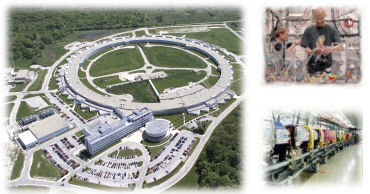National User Facilities

Argonne has several designated user facilities that are available to scientists
who would like to utilize the unique capabilities of these facilities in their
research. Access to the facilities can be obtained in several ways, the most
common of which is determined through a peer-review process for which no facility
charge is levied. Propriety research work can also be carried out at these
facilities on a full cost recovery basis.
Click here for
info on becoming a user at Argonne designated user acilities. Information about
each can be found by following the links below:
- Advanced Photon Source:
Using high-brilliance X-ray beams from the APS, members of the international synchrotron-radiation research community conduct forefront basic and applied research in the fields of materials science; biological science; physics; chemistry; environmental, geophysical, and planetary science; and innovative X-ray instrumentation.
- Argonne Tandem-Linac Accelerator System:
ATLAS is the world's first superconducting linear accelerator for heavy ions at energies in the vicinity of the Coulomb barrier. This is the energy domain best suited to study the properties of the nucleus, the core of matter, the fuel of stars.
- Center for Nanoscale Materials:
The CNM's mission includes supporting basic research and the development of advanced instrumentation that will help generate new scientific insights and create new materials with novel properties. The existence of the CNM, with its centralized facilities, controlled environments, technical support, and scientific staff, will enable researchers to excel and significantly extend their reach.
- Electron Microscopy Center:
The EMC emphasizes three major areas: materials research, technique and instrumentation development, and operation as a national research facility. Research by EMC personnel includes microscopy based studies in high-Tc superconducting materials, irradiation effects in metals and semiconductors, phase transformations, and processing related structure and chemistry of interfaces in thin films.
- Intense Pulsed Neutron Source: Commissioned in 1981, IPNS has operated continuously since start-up and has the distinction of achieving many "firsts" in neutron scattering. Virtually all first-generation time-of-flight instrumentation was developed at IPNS, and IPNS was the first DOE facility dedicated to users
|
